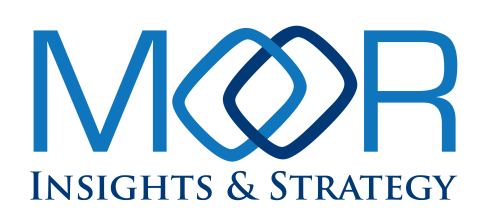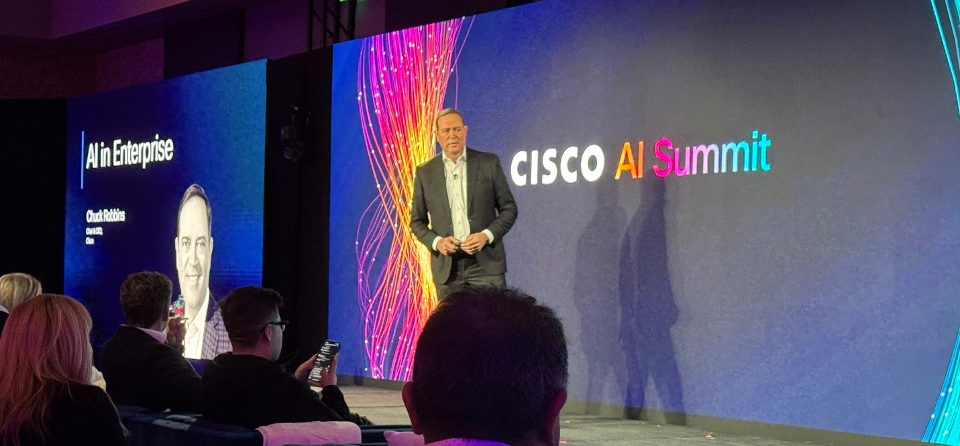
Welcome to this edition of our Weekly Analyst Insights roundup, which features the key insights our analysts have developed based on the past week’s events.
I’m not surprised that 2025 has started right where 2024 left off, with AI dominating conversations across tech. The Trump administration has only added to this with the announcement of the $500 billion Project Stargate for AI, which our analysts Paul Smith-Goodson, Matt Kimball, and Will Townsend evaluate from different angles in this week’s updates. Look for more about Project Stargate from us in the days to come.

Last week, Will also published his thoughts on the Cisco AI Summit, which he called “the best AI event I have attended to date.” (I’m not surprised; earlier this month I wrote about how thoughtful Cisco’s approach to enterprise AI has been.) Meanwhile, Anshel Sag wrote about NVIDIA’s latest graphics card for gaming PCs, the AI features of which make it, he says, “without a doubt the fastest graphics card in the world.” It’s a good reminder that even though datacenter GPUs are now the biggest financial engine for NVIDIA, the company has never abandoned its roots — nor lost its dominance — in PC graphics.
The team published a lot of research last week and did some travel as well. While I was in Davos, Anshel attended Samsung Galaxy Unpacked in San Jose and the MIT Reality Hack in Boston. This week, Robert is in Las Vegas for Acumatica Summit and then NYC for Microsoft’s AI Tour. February, March and April are already shaping up to be busy travel months for the MI&S team. Look for our thoughts on these events in upcoming installments of the MI&S Weekly Analyst Insights.
Hope you have a great week,
Patrick Moorhead
———
Our MI&S team published 25 deliverables:
- 2 Forbes Articles
- 2 Research Notes
- 5 Blog Posts
- 16 Podcasts
This past week, MI&S analysts have been quoted in top-tier publications such as Network World, Yahoo Finance, and Venture Beat with our thoughts on Databricks, Intel, Samsung, and Starlink. Robert was a guest on the WBSRocks Analysts Gone Wild Podcast to discuss enterprise software.
MI&S Quick Insights
When I was spending time with a client last week, it really stood out to me how far we’ve come lately in clarifying AI offerings. Thanks to the rampant pace of AI development over the past couple of years, sometimes the fundamentals of product management and product marketing have been deprioritized. For example, plenty of product messaging and feature descriptions have been released when they’re still at a notoriously high level across the board. But that is starting to change. I take this as a reminder that early adopters are far more tolerant of a product’s rough edges than the general market. It’s a positive sign that we are now seeing more maturity and wider adoption of enterprise AI software products. I believe it’s also a sign that things will slow down somewhat as pilots and prototypes move towards production.
I have been spending more time with NVIDIA agentic blueprints, and I can say that the detail and effort taken to document how to get the blueprints up and running is pretty impressive. This also stands out because these agents can be deployed on-premises or in a cloud. By contrast, most agentic efforts so far have been limited to a specific cloud or a SaaS platform. I am hoping that this level of deployment choice is a sign of things to come, rather than an exception.
2025 has started off with a lot of AI investing. Whether it’s ServiceNow’s acquisition of Cuein, new VC rounds at AI startups, or even the massive commitment from the Trump administration for U.S. AI data centers, it seems like investors are finally getting off the sidelines. That’s a good thing in general, but it will signal a shift in priorities for existing product teams. If you are a developer, I would expect more focus on ease of use, consumability, and samples versus net-new innovations and APIs.
Lastly, while this news is a bit old, I did want to address the hoopla that was made when Satya Nadella of Microsoft made his comments about the future of SaaS. It seems that in the tech world there is nothing we like more than declaring things dead. However . . . that’s not what he said. What will really happen is that the business-logic and user-experience layers of SaaS will be massively changed by agents. But the overall value proposition of SaaS platforms will likely remain intact.
When I was spending time with a client last week, it really stood out to me how far we’ve come lately in clarifying AI offerings. Thanks to the rampant pace of AI development over the past couple of years, sometimes the fundamentals of product management and product marketing have been deprioritized. For example, plenty of product messaging and feature descriptions have been released when they’re still at a notoriously high level across the board. But that is starting to change. I take this as a reminder that early adopters are far more tolerant of a product’s rough edges than the general market. It’s a positive sign that we are now seeing more maturity and wider adoption of enterprise AI software products. I believe it’s also a sign that things will slow down somewhat as pilots and prototypes move towards production.
I have been spending more time with NVIDIA agentic blueprints, and I can say that the detail and effort taken to document how to get the blueprints up and running is pretty impressive. This also stands out because these agents can be deployed on-premises or in a cloud. By contrast, most agentic efforts so far have been limited to a specific cloud or a SaaS platform. I am hoping that this level of deployment choice is a sign of things to come, rather than an exception.
2025 has started off with a lot of AI investing. Whether it’s ServiceNow’s acquisition of Cuein, new VC rounds at AI startups, or even the massive commitment from the Trump administration for U.S. AI data centers, it seems like investors are finally getting off the sidelines. That’s a good thing in general, but it will signal a shift in priorities for existing product teams. If you are a developer, I would expect more focus on ease of use, consumability, and samples versus net-new innovations and APIs.
Lastly, while this news is a bit old, I did want to address the hoopla that was made when Satya Nadella of Microsoft made his comments about the future of SaaS. It seems that in the tech world there is nothing we like more than declaring things dead. However . . . that’s not what he said. What will really happen is that the business-logic and user-experience layers of SaaS will be massively changed by agents. But the overall value proposition of SaaS platforms will likely remain intact.
In the opening days of his new term, President Trump announced a massive $500 billion AI project called Stargate. Supercomputers and AI datacenters will be built by key partners that include OpenAI, Oracle, SoftBank, and MGX. The project will use technology created by Arm, Microsoft, NVIDIA, Oracle, and OpenAI. SoftBank is the lead financial manager, OpenAI will handle model development and training, and Oracle will manage the data aspect. The project’s objective is to maintain U.S. leadership in AI and to create advanced AI in the form of artificial general intelligence. AGI will be able to perform a wide array of tasks with human-like intelligence, and potentially revolutionize fields like material science, medicine, and environmental science.
With an initial investment of $100 billion, construction has already begun in Abilene, Texas, where Microsoft is building an AI supercomputer. The investment is slated to ramp up to $500 billion by 2029. The plan is to establish 10 datacenters of 500,000 square feet each, with intentions to expand to another 10 across the U.S. once further site evaluations are complete. This project should create significant economic and security benefits for the U.S., especially because it emphasizes national and military security, aiming to enhance capabilities in data analysis, surveillance, and cybersecurity to safeguard against strategic threats.
To truly evaluate the project, we need more details. It appears that Microsoft initially planned to build a supercomputer exclusively for OpenAI with a $100 billion price tag, and that plan morphed into the much larger $500 billion national plan complete with supercomputer and multiple datacenters. We will need more information to fully understand the plans, how they evolved, and how they are being implemented.
Brightcove is smartly leveraging Amazon Q to address the complex technical queries from its global client base. (If you need a refresher on Amazon Q, take a look at this writeup we did last year.) By using Amazon Q, Brightcove aims to empower its support team to reduce research time and significantly improve the customer service experience, particularly for intricate issues like video embedding.
While acknowledging the potential of generative AI, Brightcove wisely emphasizes a cautious approach with rigorous testing and expert scrutiny to ensure accuracy and build trust. This focus is increasingly important in today’s AI landscape, where many companies get caught up chasing cost cuts and automation. Brightcove seems to recognize that the true potential of generative AI often lies in augmenting human capabilities and fostering deeper customer understanding.
Equipping its support team with Amazon Q will likely speed up response times and enable more effective problem-solving and stronger customer relationships. This is a strong way to leverage AI for a competitive edge. Brightcove’s strategy, with its emphasis on accuracy and human-centered implementation, highlights how accuracy, trust, and scalability can be key to maximizing the benefits of this technology to improve CX.
Adding on to my colleague’s contributions about Project Stargate, here are a few of my thoughts:
- It didn’t take long after this historic announcement for the questions to raise. If Stargate is going to be an AI venture, what exactly is the product or service being offered? Is it an AI cloud? Purely an R&D platform? Ten separate 500,000-square-foot datacenters racked with AI-specific infrastructure sounds an awful lot like a cloud to me, but maybe it isn’t.
- Is this more about creating 100,000 high-paying jobs, with the understanding that the market will find use for these datacenters in quick order? While Oracle’s Larry Ellison spoke at a high level about being able to create cancer therapies and vaccines, I’m a little confused about how this plays out specifically.
- While the investment of $500 billion over five years is incredible, what is the projected time until the first customer, partner, user, or consumer is actually using Stargate? It seems likely that the ROI on this investment will be a bit further out.
- While we know that Oracle, OpenAI, and Softbank are working in partnership with NVIDIA and Microsoft — what does this environment actually look like?
- What does Stargate mean for the cloud market? Anything? Is Stargate reserved only for the largest of large use cases that would typically require an on-premises cluster? Or is the net being spread wider to enable a real incubation across the spectrum — from the largest-of-large to the smallest-of-small companies?
I am a big fan of the government recognizing the need for the United States to stay far ahead of its competitors in any area of technology, and certainly AI is hugely important. As a country, we are already investing far more than the rest of the world combined. However, as a person who is inherently skeptical of anything the U.S. government does in the longer term, I would like to understand better the how, why, what, when, and where of Project Stargate.
When HPE launched silicon root-of-trust back in 2017, it was a game-changer in the server market. By examining and responding to the millions of lines of code that execute before a server even boots an operating system, the company provided what was the most secure server in the industry. And by integrating this with its integrated lights out (iLO) management, HPE created servers that could not only detect malware at the lowest levels, but also take corrective actions to mitigate the impact.
Since 2017, the threat landscape has evolved considerably. Quantum lockers and AI-driven malware kits create a new set of challenges that require a new way of securing platforms. Here’s the question: is the infrastructure supporting our most critical workloads evolving to meet these challenges? We’ve seen the silicon vendors respond. Now as server platforms prepare to refresh with the newest CPUs, I’ll be curious to see whether the baseboard management controllers and hardware-based security mechanisms deliver the required protection.
Customer data platforms (CDPs) are like superheroes for enterprises looking to delight their customers. They collect data from various sources and organize it in a centralized location, ensuring that everyone has access to the same insights about each customer. This collaborative approach provides better teamwork and deepens customer understanding. Armed with this comprehensive data, marketing teams can deliver personalized campaigns that make customers feel valued and encourage repeat business. CDPs serve as treasure troves of customer data, simplifying data sharing and utilization for teams.
But CDPs aren’t without their challenges. They can be tricky to scale up, especially for big companies with lots of data. And if the data isn’t accurate, it can mess up everything. Many CDPs don’t have the best analytics tools, which can make it hard to figure out what’s working and what’s not. And integrating CDPs with old systems can be a real pain.
Despite these challenges, the CDP market is growing fast. It’s expected to reach $72 billion by 2033, which is a huge increase from $7.82 billion in 2024. This growth is happening because businesses want to do a better job of engaging with their customers and making them feel valued. They also want to be able to use data to make smart marketing decisions. And they’re starting to use AI, automation, and machine learning to make CDPs even better.
If you’re a business considering CDPs, consider your needs and how you’ll use them. Ensure the CDP can handle your data, integrate with your systems, and provide analysis tools for smart decisions. CDPs are promising solutions for business growth and success. Look for my upcoming Forbes article on the state of enterprise data, which will highlight CDPs.
Ericsson recently integrated large language models into its NetCloud management platform. Thanks to this, AI agents can process network data and technical documentation to generate configuration recommendations. What is unique is that the system performs this functionality without exposing sensitive information to third parties, and thus — by design — provides a higher degree of security and control for datacenter deployments. It is also worth noting that the architecture is agentic in nature and employs multiple agents to solve complex tasks, including troubleshooting connectivity issues, automating infrastructure provisioning, and translating business intent and requirements into network policies. Such tasks have required manual intervention in the past, and if Ericsson can successfully execute in this area, it could lead to incremental enterprise networking revenue opportunities for Ericsson’s customers.
It looks like manufacturers are getting serious about AI in 2025. They’re increasing their AI budgets to become more efficient and competitive. The good news here is that they’re mainly focused on using AI to help their employees, not replace them, aligning with the principles of Industry 5.0. To leverage AI, I suggest manufacturers modernize their ERP systems, improve their data management strategies, and upgrade management processes.
Transforming your business to cloud-based ERP systems is a key for taking advantage of AI. By modernizing, manufacturers can optimize their investments and reap the benefits of the new technology.
Last week I published a case study that highlights this ERP–AI connection and the importance of modernization for making it work: “Hearst Corporation Modernizes Oracle ERP with Strong Change Management and Data Management Practices.” As enterprises adopt AI-driven solutions, it’s crucial to balance the technology advancements with addressing the human and organizational aspects of transformation. Two key pillars — change management and data management — are essential for achieving actionable outcomes. Change management focuses on organizational and human factors, while data management ensures data completeness and quality, enabling accurate and timely insights. Without both, enterprises may struggle to modernize, integrate workflows, or make informed decisions.
For this case study, I had the chance to sit down with David Hovstadius, senior vice president of finance operations at Hearst Corporation, who emphasized the importance of these principles during Hearst’s transition to Oracle Cloud ERP some years ago — which continues to pay dividends as the company embraces generative AI today. By prioritizing change management and data management, the company laid a foundation that not only facilitated its ERP implementation, but also enabled continuous technological and process improvements as AI technologies emerged. For more details, check out the article linked above.
The new Samsung Galaxy S25 smartphone launch happened last week, and it demonstrated how Google, Samsung, and Qualcomm are working in lockstep not only in mobile but also in XR with Project Moohan. Witnessing the interplay of Gemini with the depth of the Moohan experience clearly demonstrates how the three companies are working together to deliver the best AI experience in mobile. For more context on this partnership, see my coverage of last month’s launch of the Android XR spatial OS.
NXP has announced the EdgeLock A30 secure authenticator. It’s a standalone chip compatible with many MCUs and MPUs, including NPX’s MCX and i.MX products. Its minuscule size (“smaller than a grain of rice”) and standard I2C interface make it easy to fit into small devices, and NXP’s comprehensive EdgeLock 2GO certificate services ease the commissioning process. Developers need integrated solutions that conform with new and upcoming security and privacy regulations — and customer concerns. For example, the EU’s Batteries Regulation (2023/1542) requires using a Digital Product Passport by 2027, including supply chain provenance, and the EdgeLock A30 is the basis for a scalable solution. The chip has a RISC-V processor and 16 kB of NVM for credential storage, is Common Criteria EAL6+ certified, and is available now.
Last July, I reported that IBM acquired two Software AG properties – StreamSets and webMethods. Software AG’s streamlining continues with the sale of Alfabet and a management buyout of Cumulocity, the company’s IoT division. Cumulocity, founded in 2012, is once again independent after eight years under Software AG. Founder and CEO Bernd Gross told WirtschaftsWoche, “We are moving towards independence as a scale-up,” and “The big IoT boom is still to come.” I’m expecting strategic changes that better align the company with physical AI trends, making it more of a solution enabler than a solution provider.
Verizon’s new AI strategy leans on its strengths in 5G with mobile edge compute (MEC) and fiber. This creates an opportunity for businesses and even cloud providers to move their AI applications as close to the edge as possible using available compute for inference and low-latency applications. I like to see Verizon leaning in this direction because the company has struggled to differentiate its offerings from those of AT&T and T-Mobile.
Cybersecurity researchers at Sophos have discovered that threat actors have exploited Microsoft Teams to spread malicious links and files, potentially leading to ransomware infections. These attackers use AI for social engineering, making the attacks harder to detect. Microsoft has acknowledged the issue and is working on a solution. While these findings highlight specific threats to Teams, they serve as a broader warning about the increasing risk of similar attacks across all collaboration platforms. The problem is likely not isolated to Microsoft and emphasizes the need for heightened vigilance and robust security measures across the board.
My review of the RTX 5090 graphics card found that NVIDIA continues to innovate in AI. While the 5090 is a very large and power hungry card compared to the 4090, its performance is also considerably higher in 4K with DLSS 4 and 4x frame generation turned on. I also found that the AMP (AI management processor) is a RISC-V core, which is programmable and shows the allure of RISC-V for such applications.
For the first time, all the subsystems necessary to implement universal and fault-tolerant quantum computation have been combined in a photonic architecture. Xanadu has created a photonic quantum computer named Aurora that is a scale model for universal, fault-tolerant quantum computing. Aurora incorporates 35 photonic chips, 84 squeezers, and 36 photon-number-resolving detectors.
The system achieves 12 physical qubit modes per clock cycle, which means it can handle 12 qubits for each processing step, and it has synthesized a cluster state with 86.4 billion modes — reflecting the vast number of different ways 12 qubits can interact with each other. For error correction, it uses a distance-2 repetition code with real-time decoding. Aurora’s architecture is divided into three stages:
- Preparing photons to create quantum states
- Adjustment of quantum states or entangling the qubits
- The QPU performs the computations
The Aurora operates at room temperature and uses fiber-optic networking, which facilitates scalable quantum computing. Xanadu’s design is focused on fault tolerance and scalability. Compared to other photonic quantum computing efforts from makers such as PsiQuantum and Photonics, Aurora stands out with its comprehensive system design, error correction, and scalability. Shared challenges among photonic platforms remain optical loss and high qubit error rates.
Last week the Trump administration instructed the Department of Homeland Security to disband all advisory committees within the agency, including the Cyber Safety Review Board. The CSRB was created under the Biden administration in 2022 and, interestingly, played a role in investigating China-sponsored cyberattacks against U.S. telecom providers. The clean sweep of all advisory committees may simply be a resetting of the guard and a change in policy direction, but it will be interesting to see whether it impacts cyber defense negatively in the short or long term.
Something subtle that I think has been mostly overlooked: Qualcomm’s Snapdragon 8 Elite for Samsung comes with more than just a frequency bump; it also includes customizations in the Qualcomm DSP for some of the new Samsung imaging features, plus an integrated display controller on the SoC for lower power consumption. This is something probably only Samsung could achieve, but it still clearly grows out of Qualcomm’s understanding that Samsung needs something different and custom.
Technology continues to transform sports in more and more ways. One example is the TGL indoor golf league, a tech-enhanced golf league cofounded by Tiger Woods, Rory McIlroy, and Mike McCarley in partnership with the PGA Tour. Recently launched after a year-long delay due to storm damage at its SoFi Center facility in Palm Beach Gardens, Florida, TGL combines virtual and traditional golf. Matches feature six teams of four players competing in a mix of simulator-based and on-course play, including a morphing 3,800-square-foot green. The league’s unique format includes nine-hole team matches, head-to-head play, and overtime closest-to-the-pin contests, with scoring determining playoff seeding. Matches will air live on ESPN and ESPN+.
This is a pretty interesting way to showcase golf with advanced simulators, mechanically altered greens, and innovative visuals. I believe that TGL does a good job of bringing technology together while creating a unique spectator and player experience.
Meanwhile, other sports continue to try out new tech, such as soccer using semi-automated offside technology (SAOT) to make video assistant reviews (VAR) for offsides clearer and faster. But fans aren’t always on board with these changes; VAR in particular has created significant concerns among fans of the Premier League and other top leagues about transparency and how the technology affects the flow and fairness of the game. As I’ve said before, it will always be important for sports to integrate new tech while keeping important traditions alive.
5G mobile and fixed wireless access could play a pivotal role within Project Stargate, the ambitious AI effort announced in the early days of the new Trump administration. As covered elsewhere in this update, the initiative aims to invest $500 billion in infrastructure to build out AI datacenters in the United States. As gen AI becomes more hybrid from the cloud to network edges, mobility could become instrumental in the processing of smaller language models hosted in smaller edge data nodes. 5G has been searching for its killer application beyond fixed wireless access consumer services, and given 5G’s low latency, fast throughput, and massive device support advantages — it may have found it in the rollout of AI.
Forbes Articles Published
Research Notes Published
Blog Posts Published
- Data Protection In 2024 Brings Greater Automation And Resilience (Robert Kramer, Patrick Moorhead)
- MI&S Weekly Analyst Insights — Week Ending January 17, 2025 (Analyst Team)
- Google Takes A Big Step Into User-Driven Agents With Agentspace (Jason Andersen)
- Volygon Debuts Truly Photorealistic Gaussian Splats (Anshel Sag, Patrick Moorhead)
- Cisco Desk Pro Review: A Collaboration Device For Hybrid Work (Melody Brue, Patrick Moorhead)
Podcasts Published
The Enterprise Applications Podcast (Melody Brue, Robert Kramer)
DataCenter Podcast (Will Townsend, Paul Smith-Goodson, Matt Kimball)
G2 on 5G (Will Townsend, Anshel Sag)
Six Five (Patrick Moorhead)
- Insights from Infosys’s EVP Anand Swaminathan – The View From Davos
- The View from Davos with AccuWeather’s Dr. Joel N. Myers
- The View from Davos with Groq’s Jonathan Ross
- The View from Davos with Qualcomm’s Cristiano Amon
- The View from Davos with Meta‘s Yann LeCun – The Future of AI is Open and Human-Level Intelligent
- The View from Davos with Fox Rothschild’s Matthew Kittay
- The View from Davos with Workday CTO Jim Stratton
- How VCs Are Supporting AI & Sustainability – Helena Capital – The View From Davos
- Talking AI, Cybersecurity, Ransomware & Deepfakes with Check Point Software – The View From Davos
- Six Five Connected: The Need For High-Density Storage in The Age of AI
- IBM’s Rob Thomas on Generative AI, LLMs, and the Path to Value Creation at the World Economic Forum in Davos, Switzerland – The View from Davos
- The Future of Work and Technology: Exclusive Insights from Davos, Switzerland
- The Six Five: Talking Microsoft, AI Regulations, Google, Meta, and More
Don’t miss future MI&S Podcast episodes! Subscribe to our YouTube Channel here.
Citations
Databricks / Funding and Partners / Patrick Moorhead / Opentools
Databricks Scores Massive $15.25B Financing to Elevate AI Innovations
Intel / Ways to improve in 2025 / Patrick Moorhead / Network World
What Intel needs to do to get its mojo back
Intel / New CEO / Anshel Sag / Yahoo Finance
Intel races to find its next CEO, but insiders say no clear frontrunners yet
Samsung / Android XR / Anshel Sag / Venture Beat
Samsung teases Android XR devices coming later this year
Starlink / Growth under Trump Administration / Patrick Moorhead / Issues & Insights
Elon Musk’s Starlink Likely To Boom Under Trump Administration
Cohesity / Veritas Acquisition / Robert Kramer / Security Buzz
Cohesity Acquires Veritas to Become World’s Largest Data Protection Provider
New Gear or Software We Are Using and Testing
- Kindle Colorsoft (Anshel Sag)
- Google Pixel Buds 2 Pro (Anshel Sag)
- XREAL One AR Glasses (Anshel Sag)
- Google Pixel Watch 3, 41mm (Anshel Sag)
- Insta360 Link2 4K AI Webcam (Anshel Sag)
- Google TV streamer – Matter and Thread features (Bill Curtis)
- Various Matter devices (Bill Curtis)
- ASUS Zephyrus G16 Gaming Laptop (Anshel Sag)
Events MI&S Plans on Attending In-Person or Virtually (New)
Unless otherwise noted, our analysts will be attending the following events in person.
- Cisco AI Summit, January 15, Palo Alto (Will Townsend)
- World Economic Forum, January 20-24, Davos, Switzerland (Patrick Moorhead)
- Samsung Galaxy Unpacked, January 22, San Jose (Anshel Sag)
- MIT Reality Hack, Boston, January 24-17 (Anshel Sag)
- Acumatica Summit, January 26-29, Las Vegas (Robert Kramer)
- Microsoft AI Tour, January 30, New York City (Robert Kramer)
- Cisco AI Summit, January 15, Palo Alto (Will Townsend)
- World Economic Forum, January 20-24, Davos, Switzerland (Patrick Moorhead)
- Samsung Galaxy Unpacked, January 22, San Jose (Anshel Sag)
- MIT Reality Hack, Boston, January 24-17 (Anshel Sag)
- Acumatica Summit, January 26-29, Las Vegas (Robert Kramer)
- Microsoft AI Tour, January 30, New York City (Robert Kramer)
- ZohoDay25, February 3-5, Austin (Robert Kramer, Melody Brue)
- Oracle NetSuite SuiteConnect, February 6, New York City (Robert Kramer)
- Cisco Live EMEA, February 10-13, Amsterdam (Will Townsend)
- SAP Analyst Innovation Council, February 11-12, New York City (Robert Kramer)
- RingCentral Analyst Summit, February 24-26, Napa (Melody Brue)
- Arm Analyst Summit, February 18-21, San Francisco (Matt Kimball)
- Microsoft Threat Intel Summit, February 25, Redmond (Will Townsend)
- Siemens Datacenter Analyst Summit, February 25-27, Zug, Switzerland (Matt Kimball)
- EdgeAI Austin, February 25-27, Austin (Bill Curtis is a speaker)
- Mobile World Congress, March 2-7, Barcelona (Will Townsend)
- Susecon, March 10-14, Orlando (Matt Kimball)
- Fastly Accelerate, March 12, Los Angeles (Will Townsend)
- Synopsys Panel Moderation, March 15, San Jose (Matt Kimball)
- Adobe Summit, March 18-20, Las Vegas (Melody Brue)
- Extreme Networks Connect, May 19-22, Paris (Will Townsend)
- Zendesk Analyst Day, March 25, Las Vegas (Melody Brue)
- Oracle Database Summit, March 25, Mountain View (Matt Kimball)
- IBM Infrastructure Analyst Summit, March 25, NYC (Matt Kimball, Melody Brue)
- Microsoft FabCon March 31–April 2, Las Vegas (Robert Kramer)
- Canva Create & Analyst Day, April 8-10, Los Angeles (Melody Brue)
- Infor Analyst Innovation Summit, April 8-9, NYC (Robert Kramer)
- NTT Upgrade, April 9-10, San Francisco (Will Townsend)
- Google Next, April 9-11, Las Vegas (Robert Kramer)
- Appian World, April 27-30, Denver (Robert Kramer)
- RSA Conference, April 28-May 1, Las Vegas (Will Townsend)
- Nutanix.NEXT May 6-9, Washington DC (Matt Kimball)
- Informatica World, May 13-15, Las Vegas (Robert Kramer)
- Fastly Accelerate, May 14, Los Angeles (Will Townsend)
- Dell Tech World, May 19-22, Las Vegas (Matt Kimball)
- Zscaler Zenith Live, June 2-5, Las Vegas (Will Townsend)
- Snowflake, June 2-5, San Francisco (Robert Kramer)
- Cisco Live US, June 8-12, San Diego (Will Townsend)
- HPE Discover, June 23-26, Las Vegas (Will Townsend)
- Techritory, October 22-23, Riga (Will Townsend)
Subscribe
Want to talk to the team? Get in touch here!






























































































